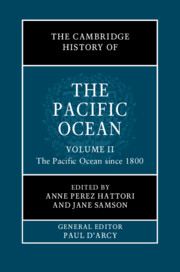Book contents
- The Cambridge History of the Pacific Ocean
- The Cambridge History of the Pacific Ocean
- The Cambridge History of the Pacific Ocean
- Copyright page
- Contents
- Figures
- Tables
- Contributors to Volume II
- Frontispiece
- General Editor’s Introduction
- Preface to Volume II
- Part VII Rethinking the Pacific
- Part VIII Approaches, Sources, and Subaltern Histories of the Modern Pacific
- 37 Archives and Community Memory in the Pacific
- 38 Missing in Action
- 39 Rethinking Gender and Identity in Asia and the Pacific
- 40 Fifty Years of The Hawaiian Nation
- 41 Pacific Literature and History
- 42 Film and Pacific History
- 43 The Visual and Performing Arts of the Pacific
- Part IX Culture Contact and the Impact of Pre-colonial European Influences
- Part X The Colonial Era in the Pacific
- Part XI The Pacific Century?
- Part XII Pacific Futures
- References to Volume II
- Index
41 - Pacific Literature and History
from Part VIII - Approaches, Sources, and Subaltern Histories of the Modern Pacific
Published online by Cambridge University Press: 11 November 2022
- The Cambridge History of the Pacific Ocean
- The Cambridge History of the Pacific Ocean
- The Cambridge History of the Pacific Ocean
- Copyright page
- Contents
- Figures
- Tables
- Contributors to Volume II
- Frontispiece
- General Editor’s Introduction
- Preface to Volume II
- Part VII Rethinking the Pacific
- Part VIII Approaches, Sources, and Subaltern Histories of the Modern Pacific
- 37 Archives and Community Memory in the Pacific
- 38 Missing in Action
- 39 Rethinking Gender and Identity in Asia and the Pacific
- 40 Fifty Years of The Hawaiian Nation
- 41 Pacific Literature and History
- 42 Film and Pacific History
- 43 The Visual and Performing Arts of the Pacific
- Part IX Culture Contact and the Impact of Pre-colonial European Influences
- Part X The Colonial Era in the Pacific
- Part XI The Pacific Century?
- Part XII Pacific Futures
- References to Volume II
- Index
Summary
Ours is a sea of writing. Historians, anthropologists, and linguists pore over documents, putting together paper puzzle pieces and figuring out how they fit. Social scientists, educators, development specialists, NGO administrators, activists, scientists, cultural specialists, politicians, journalists, preachers, entrepreneurs, and social media junkies spend hour after hour stringing words into sentences, and sentences into paragraphs (or hashtags). Thanks to the deeply stalkerish tendencies of the colonial project, archives are groaning with paper on which our lives, perspectives, experiences, and knowledges have been transcribed. In the Pacific we like to hold paper writing alongside other kinds of texts and sources: oral, musical, woven, carved, danced, and so on. Tatau, moko, veiqia, kakau kirituhi, record, communicate, and adorn our bodies. Small slabs of very old carved wood bear the evidence of Rongorongo, the currently indecipherable script produced in Rapa Nui. But none of these other texts lessen the value of alphabetic writing – they just place it in a broader context of articulation and representation.
- Type
- Chapter
- Information
- The Cambridge History of the Pacific Ocean , pp. 246 - 265Publisher: Cambridge University PressPrint publication year: 2023



